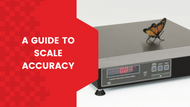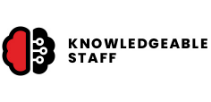A Guide to Scale Accuracy
Posted by Ben M. on Mar 21st 2023
Scale accuracy is important when it comes to weighing. The fact is, if you are weighing anything at all, it's safe to say you're doing so because you need a precise measurement. While many folks assume accuracy and readability go hand-in-hand, there is much more to the equation than that.
So, how do you know if your scale is accurate?
Before we can answer that, it would be helpful to know what scale accuracy is. In our Scale Definitions Glossary, we define accuracy as:
“How well a scale can display the weight of a sample relative to the true weight of the sample. This is closely related to the combination of the display resolution and consistency of the performance of the scale.”
In addition to the display resolution, other major factors contribute to digital scale accuracy. These include:
- Repeatability
- Linearity
- Reproducibility
- Calibration adjustment procedures
While this is not an exhaustive list by any means, these four factors are very prominent when determining if you have an accurate scale or not. So, that’s what we’re going to cover here in this guide. Without further ado, let’s break down these various specifications and how to know if your scale is accurate.
READABILITY
What is scale readability?
Readability—also known as resolution or division size—is the smallest increment the scale’s displayed measurement can change as weight is added to or removed from the scale.
How does readability affect scale accuracy?
Generally speaking, one might assume that a scale with a readability of 0.2 lb. would be more accurate than a scale with a readability of 0.5 lb. However, when it comes to scales and balances, it would be better to say the scale with a readability of 0.2 lb. can display a more precise weight value than the scale with a readability of 0.5 lb. You may even find a scale that has a readability of 0.2 lb. but is not as accurate as a scale with a readability of 0.5 lb. This is because many more factors contribute to the overall digital scale accuracy than the displayed readability.
REPEATABILITY
What is scale repeatability?
Repeatability describes how well a scale will display the exact value when the same weight is repeatedly placed on the scale. Most scale manufacturers use an estimated value for repeatability in their scale specification sheets, which is generally a good reference to use when comparing one model to another. Keep in mind that this number is just an estimate, though, and each scale will deviate somewhat from the estimated manufacturer’s specified value.
How to calculate scale repeatability
To keep things simple, let’s say a scale with a readability of 0.2 lb. has a manufacturer’s specified repeatability of +/- 5 divisions. To calculate the repeatability, we would multiply the division size by the number of divisions specified (0.2 x 5) for an estimated repeatability of +/- 1 lb.
Now, for comparison, let’s say a scale with a readability of 0.5 lb. has a manufacturer’s specified repeatability of +/- 1 division. Having done the calculation above once more, you’d determine that this scale has an estimated repeatability of 0.5 lb.
So, which scale is more accurate? In this case, we’d say the scale with the 0.2 lb. resolution has a high displayed precision with lower accuracy while the scale with 0.5 lb. resolution has a low displayed precision with higher accuracy.
LINEARITY
What is scale linearity?
When it comes to determining scale accuracy, linearity is also an important factor to consider. Linearity is a measurement of how well a scale displays the correct weight value throughout its full capacity range. As was true with repeatability, many scale manufacturers provide an estimated value for linearity.
How to test scale linearity
To illustrate, let’s say the same scale used before with a readability of 0.2 lb. has a capacity of 1,000 lbs. If the scale is linear, it would display 500.00 pounds when 500.00 pounds of test weight is placed on it. Likewise, it will display 1000.00 lbs. when tested with 1000.00 lbs.
If the scale is not linear, you might end up with the following scenario:
- 500.00 lbs. is placed on the scale and it displays 500.60 lbs.
- 1000.00 lbs. is then placed on the scale and it displays 1000.00 lbs.
If you were to plot these points on a graph and then connect the dots, you wouldn’t end up with a perfectly straight line. So, as you can see, a scale that has linearity errors may be accurate at some weights but not at others.
REPRODUCIBILITY
What is scale reproducibility?
Another contributor to the accuracy of a scale or balance is reproducibility. Reproducibility is defined by the capability of a scale to display the correct weight value over time—even when outside weighing conditions change.
Examples of changing conditions may include:
- Fluctuations in ambient temperature
- A change in scale level
- Overloading a scale past its specified capacity
How is scale reproducibility measured?
Since there is a multitude of factors that can affect reproducibility, it's hard to determine an estimated value for reproducibility as a whole. However, many manufacturers provide values that will help in comparing the reproducibility of one scale to another.
The two most common specifications that manufacturers publish values for are:
- A change in temperature
- The overload protection value
These metrics will help you determine how accurate a scale will remain given changes in your environment and the impact of overload.
CALIBRATION PROCEDURE
It would be an injustice to tell you about all the specifications that help determine the accuracy of a scale without also explaining how to maintain that accuracy. So that brings us to calibration procedures.
Every calibration procedure should, at a minimum, identify the following:
- Time intervals between calibrations
- Calibration test points
- Allowable tolerances (how far off a scale can be and still be acceptable)
- Calibration adjustment methods
- A decision method for how to handle a scale that is found to be out of tolerance
When the accuracy of a scale is exceptionally important, the calibration interval is usually more frequent. To perform an accurate calibration, the accuracy of the test weights used for the calibration must be considered. Using test weights of a lower accuracy than what the scale is capable of measuring will almost always result in a scale that isn’t as accurate as it could be. Calibration test points should be identified and proper allowable tolerances must be determined so the person performing the calibration can determine the appropriate weights to use for the calibration.
A decision method must also be developed so the person performing the calibration knows what to do when a scale is found to be out of tolerance. For example:
- Does the scale need to be pulled from the production line?
- Does it have to be marked inactive and quarantined?
- Can the calibration just be adjusted and if it adjusts properly can it be left in the production line, or could it be serious enough that a product recall is triggered?
If the incorrect tolerances have been determined for a scale—or no decision method is developed for when an out-of-tolerance condition occurs—it can lead to a very serious situation.
One example is the measurement of medication dosages at a veterinary clinic. These dosages are typically determined by the weight of the animal, so if the scale used to weigh the animal is thought to be accurate—but in reality, is not—the medication dosage may end up being incorrect. As we all know, having too much medication can lead to serious complications or even death.
FINAL WORD ON SCALE ACCURACY
As we’ve learned, it is incredibly important to look at more than just the readability of a scale when determining its accuracy. The best place to begin before purchasing a new scale is to fully understand your weighing process, internal quality guidelines, and calibration methods. If you're bound by industry or government regulations pertaining to quality standards, these too should be considered.
Once you've chosen a new scale, proper control of external factors that may affect the performance of your scale must be both considered and addressed. To learn more about scale accuracy and calibration, we encourage you to check out one of our other guides below.
- 5-step scale calibration guide
- Internal versus external calibration
- What is NIST traceable calibration and where do I get a NIST traceable calibration certificate for my scale?
Of course, if you have any other questions about scale accuracy or calibration, don’t be shy! Give us a call at 616-622-2100 or shoot us an email and one of our in-house scale experts will get you the answer you need ASAP.





